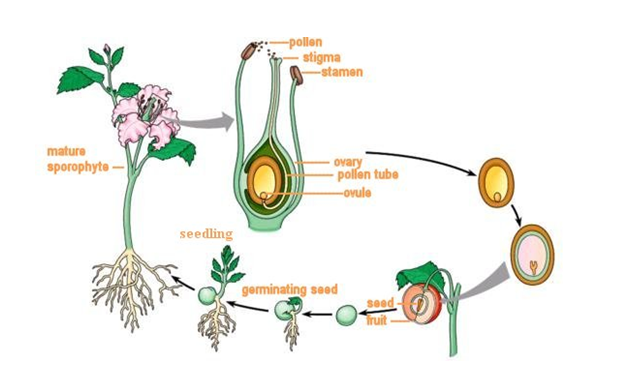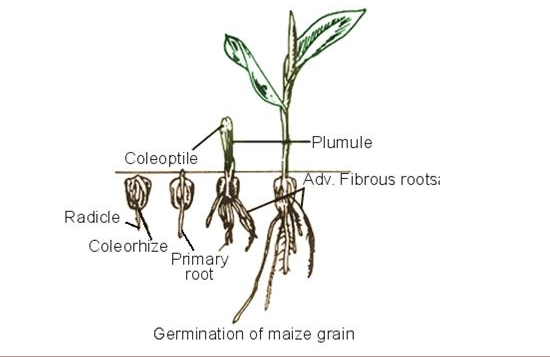Back to: BIOLOGY SS3
Welcome to class!
In today’s class, we will be talking about the development of new organisms (seeds, fruits in plants, germination of seeds). Enjoy the class!
Development of Zygote in Flowering Plants, Germination of Seeds, Adaptive Features in a Developing Animal

CONTENT
- Fertilization and development of zygote in plants
- Formation of seeds and fruits
- Germination of seeds and condition necessary for germination
- Adaptive features in a developing animal
- Definition of oviparity, viviparity and ovoviviparity
Development of Zygote in plants
Pollination is followed by fertilization and the development of zygote in flowering plants during which the flower changes into a fruit enclosing the seeds. The male and female sex cells that form zygote at fertilization are the pollen grain and the ovule. The following are the processes involved.

- After pollination: the pollen grain absorbs a sugary liquid on the stigma swells and germinates.
- The outer coat of the pollen grain splits and the pollen tube grows out and down inside the style.
- The nucleus of the pollen grain divides into two – a large tube nucleus and a smaller generative nucleus. The male nucleus is the male gamete.
- One of the male nuclei: after their release into the embryo sac, fuses with the ovule to form a zygote which develops into the embryo this is called first fertilization.
- Second fertilization takes place when the second male nucleus fuses with the secondary nucleus to form the endosperm nucleus which produces the endosperm (food storehouse of the embryo).
Formation of seeds and fruit (Development of embryo)
The zygote divides by mitosis to form many cells which differentiate and become organized into an embryo. The embryo is made up of the following parts:
- the plumule (embryonic shoot)
- the radicle (embryonic root)
- one or two cotyledons (seed leaves)
- endosperm (they could be absent )
As the embryo develops, the ovary and the ovules change and develop into fruit and seed or seeds respectively.
Seed
A seed is defined as the ripened, fertilized and developed ovule. The structure of the seed has the following parts
- seed coat –This is the outer membrane of the seed
- hilum – is the point of attachment of the seed to the seed stock
- Micropyle – The tiny hole through which air and water get into the embryo of the seed. The embryo is the innermost part of the seed.
A seed with one seedling is called monocotyledon e.g. cereals such as maize, millet, rice, sorghum, wheat etc. Those with two seed leaves are called dicotyledonous plant e.g. mango, beans.
Evaluation
- (a) What is a seed (b) Describe the structure of a seed
- Describe the stages involved in the development of zygote in flowering plants
Germination of seeds
Germination is the process of the gradual development of the embryo seed into the seedling or the young plant. The embryo of the developed seeds usually undergoes a rest period called dormancy and the seed remains in this condition as long as the conditions for germination are unfavourable. There are two types of germination
a. Epigeal germination: This is when the seedling emerging from the soil carries the cotyledon above the soil surface e.g. dicotyledonous plant.


b. Hypogeal germination: This is when the seedling emerges from the soil with the cotyledon left below the soil e.g. monocotyledonous plant.
Conditions necessary for seed germination
- An adequate supply of water or moisture which helps to activate the soil and make the seed coat soft for further development.
- Oxygen is needed for respiration for the generation of energy needed for the growth of the seed.
- Optimum temperature
- Enzymes are needed to speed up the rate at which the food is broken down to release energy.
- Food or energy (in dicot seed, the food is stored in the cotyledon while in monocot plant the food is stored in the endosperm).
- The seeds must be viable.
Evaluation
- What is germination?
- What are the conditions necessary for germination of seeds?
Adaptive features in developing animals
EGGS OF FISH, AMPHIBIANS, REPTILES AND BIRDS
All vertebrates except mammals are egg-laying animals. The egg has the following features that help the embryo to develop inside it.
- Shell: Hard, porous and rich in calcium carbonate. It protects the egg and aid respiration.
- Membranes: Also aid protection of the egg.
- Albumen: It is called the egg white and accounts for over 50% of the egg. It nourishes the embryo.
- Yolk: Located at the centre of the egg. It is rich in vitamins, protein and minerals to nourish the embryos.
- Chalaza: A piece of thick protoplasm that extends to both side of the yolk to hold the embryo in position.
Developing embryo/foetus in mammals
The embryo or foetus has the following adaptive features.
1. Uterus: Immediately after fertilization in the oviduct the embryo is planted in the wall of the uterus.
2. Placenta: the connection between the embryo and the mother in mammals.
- It carries oxygen, water and food from the mother’s blood to the embryo blood.
- It also removes excretory waste like urea, salt and carbon dioxide from the embryo’s blood and transfers it to the mother’s bloodstream for elimination.
- It produces hormones which help the mother to adapt to the pregnancy.
3. Umbilical cord: It helps to attach the embryo to the placenta. The arteries and vein of the cord carry the blood of the foetus to and from the placenta. The blood of the mother and the foetus are separated and so do not mix
4. Embryonic membranes: These membranes envelop the foetus to provide it with adequate protection. The membranes include
- Amnion which is the innermost membrane filled with the amniotic fluid which serves as a cushion or shock absorber for the embryo. The fluid also neutralizes the effect of changes in external temperature.
- Chorion is the outermost membrane which absorbs oxygen for the embryo.
- The allantois is a membrane which aids respiration and excretion in developing
Evaluation
- Describe the structure of egg in birds.
- What are the functions of the placenta in mammals?
Definition of oviparity, viviparity, ovoviviparity
- Oviparity is a process of reproduction in which eggs are laid into the external environment where the embryos complete their development and hatch out of the eggs as young. Most fishes, amphibians, reptile and eggs undergo this type of reproduction.
- Viviparity is a process of reproduction in which the young develops and nourished inside the female’s body through the placenta and are born alive when fully developed. A few fishes, reptiles and all mammals are viviparous animals.
- Ovoviviparity takes place in few fishes and reptiles where the laid eggs are retained in the body of the female without placenta and when fully develop the young hatch from the eggs and are released from the female’s body.
Evaluation
Differentiate between oviparity, viviparity and ovoviviparity.
General evaluation
- Describe the process of zygote formation in flowering plants.
- What is a seed
- With a labelled diagram, describe a seed.
- What is germination?
- Define epigeal and hypogeal germination
- What are the conditions necessary for seed germination
- With the aid of a labelled diagram, describe the adaptive features of egg in birds
- Differentiate between oviparity, viviparity and ovoviviparity giving one example in each case.
Reading assignment
College Biology, chapter 16, page 324 – 326, 382 – 387
Weekend assignment
- The process by which fruits develop without fertilization is known as a) germination b) pathenocarpy c) viviparity d) pollination
- Which of these is not an oviparous animal a) goat b) pigeon c) lizard d) toad
- A seed consists of the following parts except a) micropyle b) endosperm c) endocarp d) hilum
- An embryonic shoot in a plant is known as a) radical b) plumule c) endosperm d) cotyledon
- The part of an egg that holds the embryo in position is the a) yolk b) albumen c) shell d) chalaza
Theory
- Describe the structure and functions of the placenta in mammals.
- Differentiate between hypogeal and epigeal germination
We hope you enjoyed the class.
Should you have any further question, feel free to ask in the comment section below and trust us to respond as soon as possible.
